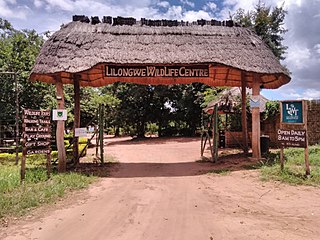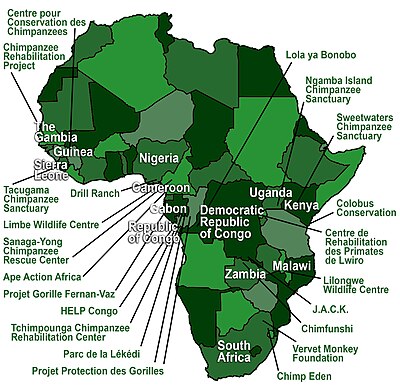
The chimpanzee, also known as simply the chimp, is a species of great ape native to the forests and savannahs of tropical Africa. It has four confirmed subspecies and a fifth proposed one. When its close relative the bonobo was more commonly known as the pygmy chimpanzee, this species was often called the common chimpanzee or the robust chimpanzee. The chimpanzee and the bonobo are the only species in the genus Pan. Evidence from fossils and DNA sequencing shows that Pan is a sister taxon to the human lineage and is humans' closest living relative. The chimpanzee is covered in coarse black hair, but has a bare face, fingers, toes, palms of the hands, and soles of the feet. It is larger and more robust than the bonobo, weighing 40–70 kg (88–154 lb) for males and 27–50 kg (60–110 lb) for females and standing 150 cm.

The bonobo, also historically called the pygmy chimpanzee, is an endangered great ape and one of the two species making up the genus Pan. While bonobos are, today, recognized as a distinct species in their own right, they were initially thought to be a subspecies of Pan troglodytes, due to the physical similarities between the two species. Taxonomically, the members of the chimpanzee/bonobo subtribe Panina—composed entirely by the genus Pan—are collectively termed panins.

Bushmeat is meat from wildlife species that are hunted for human consumption. Bushmeat represents a primary source of animal protein and a cash-earning commodity for inhabitants of humid tropical forest regions in Africa, Latin America and Asia. Bushmeat is an important food resource in poor, rural communities.

Twycross Zoo is a medium to large zoo near Norton Juxta Twycross, Leicestershire. The zoo has the largest collection of monkeys and apes in the Western World, and in 2006 re-launched itself as "Twycross Zoo – The World Primate Centre".
The Born Free Foundation is an international wildlife charity that campaigns to "Keep Wildlife in the Wild". It protects wild animals in their natural habitat, campaigns against the keeping of wild animals in captivity and rescues wild animals in need. It also promotes compassionate conservation, which takes into account the welfare of individual animals in conservation initiatives. Born Free also creates and provides educational materials and activities that reflect the charity's values.

Chimfunshi Wildlife Orphanage is a sanctuary for chimpanzees, located in Zambia's Copperbelt Province. Chimfunshi started as a family-run wildlife orphanage, and today Chimfunshi is managed by a board of trustees to ensure the long-term sustainability of the sanctuary. Chimfunshi was founded in 1983 when a game ranger brought a badly wounded infant chimpanzee to the cattle ranch of David and Sheila Siddle. The Siddles nursed that chimp – named "Pal" – back to health, thereby establishing a tradition of care and respect that forms the legacy of the sanctuary. Once word of Pal's recovery spread, the Siddles were inundated with orphaned chimpanzees. Although many of the chimpanzees were confiscated from poachers who attempted to smuggle the infants into Zambia for sale as pets, an equally large number were rescued from dilapidated zoos and circuses from all over Africa, Asia, Europe and South America. With over 145 chimpanzees, Chimfunshi is now one of the largest chimpanzee sanctuaries in the world.
The International Primate Protection League (IPPL) is a not-for-profit animal welfare organization founded in 1973 in Thailand by Shirley McGreal.

The wildlife of the Democratic Republic of the Congo includes its flora and fauna, comprising a large biodiversity in rainforests, seasonally flooded forests and grasslands.
Frances J. White is a British biological anthropologist, professor, and primatologist at the University of Oregon. As a behavioral ecologist, her research focuses on the evolution of primate sociality and social systems. She has studied the socioecology of the bonobo chimpanzee for over 35 years at Lomako Forest in the Democratic Republic of Congo. She is the foremost American authority on this species in the wild and has done extensive field research on the bonobo or pygmy chimpanzees. Her bonobo research examines why bonobos have evolved a very different social system compared to the closely related chimpanzee.

Founded by Claudine André in 1994, Lola ya Bonobo is the world's only sanctuary for orphaned bonobos. Since 2002, the sanctuary has been located just south of the suburb of Kimwenza at the Petites Chutes de la Lukaya, Kinshasa, in the Democratic Republic of the Congo.

The Vervet Monkey Foundation (VMF) is a 23-hectare not-for-profit centre for rehabilitation, education and sanctuary for vervet monkeys, near the town of Tzaneen, South Africa. Registered and established in 1993, it is situated approximately 80 miles south of the Tropic of Capricorn. The sanctuary is a member of the Pan African Sanctuary Alliance (PASA), and the Global Federation of Animal Sanctuaries (GFAS). The foundation relies heavily on volunteer workers primarily from western countries to assist in the day-to-day running and care duties of the foundation.

Ape Action Africa is a non-profit NGO founded in 1996 dedicated to the conservation of endangered gorillas and chimpanzees, threatened by the bushmeat trade in Central and West Africa. Ape Action Africa manages the rescue and rehabilitation of Great apes across much of Cameroon, with a large sanctuary in the Mefou forest. Some of these Apes include the Western gorilla, Western lowland gorilla, Cross River gorilla, and the Nigeria-Cameroon chimpanzee. With more than 300 primates in its care, Ape Action Africa is now one of the largest conservation projects of its kind in Africa. Many of the animals arrive at the sanctuary as orphans, mainly due to the illegal bushmeat trade, which has grown in recent years as a result of deforestation of the Cameroonian jungle.

The Tchimpounga Sanctuary, also known as the Tchimpounga Chimpanzee Rehabilitation Center, for primates is located on a coastal plain of savanna and forest in the Republic of the Congo, and was built in 1992. The site covers an area of 70 square kilometres (27 sq mi). The sanctuary, part of the Jane Goodall Institute, is located 50 km north of Pointe-Noire in the Kouilou Department and is the largest chimpanzee sanctuary on the African continent. It has conducted research comparing food-sharing and social inhibition among chimpanzees and bonobos.
Rachel Hogan, is a British primate conservationist, living and working in Cameroon in West Africa, and director of the charity Ape Action Africa.
Magdalena (Magda) Bermejo is a Spanish primatologist and world authority on the western lowland gorilla. Since 1991 she has lived for long periods with her husband, German Illera, in the rainforests of the Republic of Congo, conducting research and becoming increasingly involved in gorilla conservation. She estimated that 5,000 gorillas died from Ebola in Gabon and the Republic of Congo.

The Lilongwe Wildlife Centre is a wildlife sanctuary in Lilongwe, Malawi. It was founded in 2007 by the Lilongwe Wildlife Trust (LWT) and the Born Free Foundation. The Centre is a member of the Pan African Sanctuary Alliance and the Global Federation of Animal Sanctuaries.
Lomami National Park is a national park located in the Democratic Republic of Congo in Central Africa. Situated within the middle basin of the Lomami River, it straddles the Provinces of Tshopo and Maniema with a slight overlap into the forests of the Tshuapa and Lualaba river basins. The National Park was formally declared on 7 July 2016. It is the 9th national park in the country and the first to be created since 1992.
Mefou Park, also known as Mefou Wildlife Sanctuary and Mfou Reserve, is a primate sanctuary in the forested area of Mfou in Cameroon. Within it, Mefou Primate Park is used as a shelter for primates that are native to Africa: the monkey, chimpanzees and gorillas.
The Chimpanzee Rehabilitation Project (CRP) is a rehabilitation center associated with the Pan African Sanctuary Alliance (PASA), located at the River Gambia National Park (RGNP), established in 1979. It is the home of 100 chimpanzees living free in four separate groups spread in three islands.
The Kokolopori Bonobo Reserve is a nature reserve in the Democratic Republic of the Congo. The 4,875-square-kilometre (1,882 sq mi) reserve is a protected area for endangered bonobos and uses a community-based model of natural resource management undertaken by residents of the villages of Kokolopori and the local conservation organisation Vie Sauvage.











